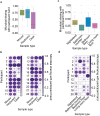Human microbiome transfer in the built environment differs based on occupants, objects, and buildings
- PMID: 37081054
- PMCID: PMC10116103
- DOI: 10.1038/s41598-023-33719-6
Human microbiome transfer in the built environment differs based on occupants, objects, and buildings
Abstract
Compared to microbiomes on other skin sites, the bacterial microbiome of the human hand has been found to have greater variability across time. To increase understanding regarding the longitudinal transfer of the hand microbiome to objects in the built environment, and vice versa, 22 participants provided skin microbiome samples from their dominant hands, as well as from frequently and infrequently touched objects in their office environments. Additional longitudinal samples from home environments were obtained from a subset of 11 participants. We observed stability of the microbiomes of both the hand and built environments within the office and home settings; however, differences in the microbial communities were detected across the two built environments. Occupants' frequency of touching an object correlated to that object having a higher relative abundance of human microbes, yet the percent of shared microbes was variable by participants. Finally, objects that were horizontal surfaces in the built environment had higher microbial diversity as compared to objects and the occupants' hands. This study adds to the existing knowledge of microbiomes of the built environment, enables more detailed studies of indoor microbial transfer, and contributes to future models and building interventions to reduce negative outcomes and improve health and well-being.
© 2023. This is a U.S. Government work and not under copyright protection in the US; foreign copyright protection may apply.
Conflict of interest statement
Dr. Brenner reports Grants from the VA, DOD, NIH, and the State of Colorado, editorial renumeration from Wolters Kluwer, and royalties from the American Psychological Association and Oxford University Press. In addition, she consults with sports leagues via her university affiliation. Dr. Postolache reports financial support from the VA, NIH, the state of Maryland, and the DC Department of Behavioral Health. Dr. Lowry reports grants from the NIH, NSF, and VA. In addition, Dr. Lowry serves on the Scientific Advisory Board of Immodulon Therapeutics, Ltd., is Cofounder, Board Member, and Chief Scientific Officer of Mycobacteria Therapeutics Corporation, and is a member of the faculty of the Integrative Psychiatry Institute, Boulder, Colorado. The remaining authors declare that the research was conducted in the absence of any relevant commercial or financial relationships that could be construed as a potential conflict of interest.
Figures




Similar articles
-
Longitudinal homogenization of the microbiome between both occupants and the built environment in a cohort of United States Air Force Cadets.Microbiome. 2019 May 2;7(1):70. doi: 10.1186/s40168-019-0686-6. Microbiome. 2019. PMID: 31046835 Free PMC article.
-
The roles of the outdoors and occupants in contributing to a potential pan-microbiome of the built environment: a review.Microbiome. 2016 May 24;4(1):21. doi: 10.1186/s40168-016-0165-2. Microbiome. 2016. PMID: 27216717 Free PMC article. Review.
-
Microbial Ecology of Atlantic Salmon (Salmo salar) Hatcheries: Impacts of the Built Environment on Fish Mucosal Microbiota.Appl Environ Microbiol. 2020 Jun 2;86(12):e00411-20. doi: 10.1128/AEM.00411-20. Print 2020 Jun 2. Appl Environ Microbiol. 2020. PMID: 32303543 Free PMC article.
-
Microbiome dynamics during the HI-SEAS IV mission, and implications for future crewed missions beyond Earth.Microbiome. 2021 Jan 24;9(1):27. doi: 10.1186/s40168-020-00959-x. Microbiome. 2021. PMID: 33487169 Free PMC article.
-
Building upon current knowledge and techniques of indoor microbiology to construct the next era of theory into microorganisms, health, and the built environment.J Expo Sci Environ Epidemiol. 2020 Mar;30(2):219-235. doi: 10.1038/s41370-019-0157-y. Epub 2019 Jul 15. J Expo Sci Environ Epidemiol. 2020. PMID: 31308484 Free PMC article. Review.
Cited by
-
Molecular Signature Associated With Acute Rejection in Vascularized Composite Allotransplantation.Transplant Direct. 2024 Sep 19;10(10):e1714. doi: 10.1097/TXD.0000000000001714. eCollection 2024 Oct. Transplant Direct. 2024. PMID: 39310283 Free PMC article.
-
Functional areas shape indoor microbial structure and potential risks in university dormitories.Front Microbiol. 2025 Jul 15;16:1604064. doi: 10.3389/fmicb.2025.1604064. eCollection 2025. Front Microbiol. 2025. PMID: 40735623 Free PMC article.
-
Medico-Legal Applications of the Human Microbiome and Critical Issues Due to Environmental Transfer: A Review.Microorganisms. 2024 Nov 25;12(12):2424. doi: 10.3390/microorganisms12122424. Microorganisms. 2024. PMID: 39770627 Free PMC article. Review.
-
Microbial landscape of Indian homes: the microbial diversity, pathogens and antimicrobial resistome in urban residential spaces.Environ Microbiome. 2025 Feb 25;20(1):25. doi: 10.1186/s40793-025-00684-8. Environ Microbiome. 2025. PMID: 40001165 Free PMC article.
-
Biocontrol in built environments to reduce pathogen exposure and infection risk.ISME J. 2024 Jan 8;18(1):wrad024. doi: 10.1093/ismejo/wrad024. ISME J. 2024. PMID: 38365248 Free PMC article. Review.
References
Publication types
MeSH terms
Grants and funding
LinkOut - more resources
Full Text Sources

